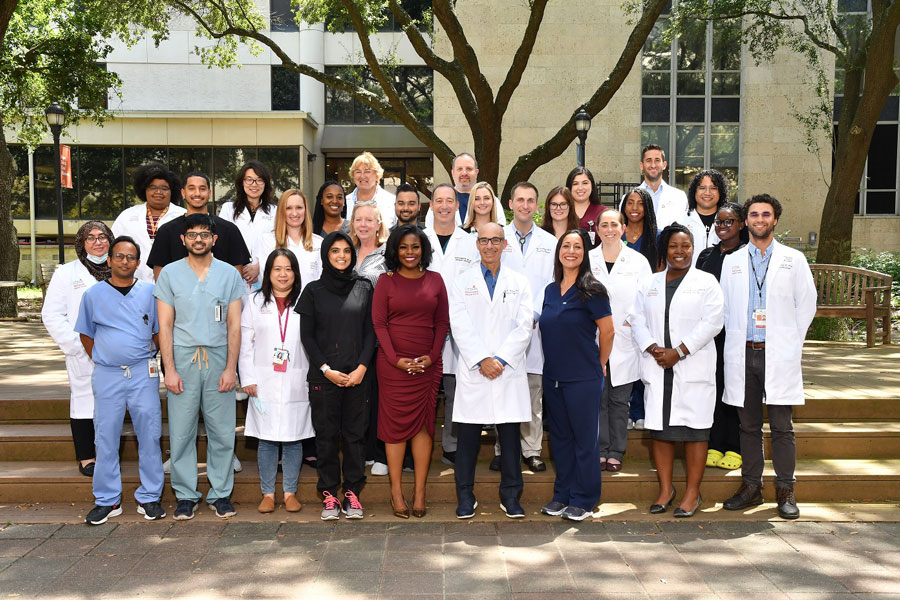Collaborative research brings bench findings to patients with acute respiratory distress syndrome

In the midst of a pandemic, when the world was focused on survival and infection prevention, a cross-section of collaborative clinical and basic science McGovern investigators embarked upon a multisite clinical trial to help the sickest COVID-19 patients — those who developed severe lung injury referred to as acute respiratory distress syndrome (ARDS).
“During COVID, people were scared and looking for answers, and we were a group that was trying to find an answer,” said Sam Luber, MD, MPH, ad interim chair of the Department of Emergency Medicine. “It was truly amazing that we were able to put this together during the pandemic and accomplish a clinical trial that enrolled over 400 patients.”
Building upon research that hypoxia-inducible factors promote lung protection and pathogen eradication during acute lung injury, McGovern researchers recently published “Identification of HIF1A as a therapeutic target during SARS-CoV-2-associated lung injury,” in JCI insights, which details results of a randomized, double-blinded, multicenter phase II trial in patients admitted for SARS-CoV-2 infection and concomitant hypoxia.
HIFs promote adaptations to limited oxygen availability, dampening alveolar inflammation and pulmonary edema, as well as helping the lung recover following inflammation. Vadadustat is a HIF stabilizer that is FDA approved for treating anemia in patients with dialysis-dependent chronic kidney disease. This clinical trial tested the hypothesis that vadadustat attenuates SARS-COV-2-associated lung injury.
“We saw a very high likelihood that vadadustat would be beneficial in preventing ARDS during COVID-19. In particular, patients who came in and were very sick and required a lot of oxygen, the chances of the HIF activator being protective for the lungs was very, very high,” said Holger Eltzschig, MD, PhD, chair of the Department of Anesthesiology, Critical Care and Pain Medicine and co-lead author of the study. “So, we think that people who have severe pathogen-associated lung injury are highly likely to benefit from this drug.”
The scientific collaboration featured a mix of basic science and frontline clinical experts to bring new treatment options to patients.
“Our lab has been working on this molecule hypoxia-inducible factor – so called HIF – for quite some time, and we have identified many different mechanisms on how it can provide lung protection,” said Xiaoyi Yuan, PhD, assistant professor of anesthesiology. “This project for us is somewhat of a dream come true because it’s quite rare for what you’re working on in the basic translation laboratory can actually be implemented in the treatment of our patients.”
The Department of Emergency Medicine led the study on the clinical side, caring for and enrolling patients.
“Our findings—from promising preclinical models to encouraging results in a multi-center randomized clinical trial—suggest that targeting HIF pathways could be a novel and powerful approach to protecting patients with acute respiratory failure,” said Bentley Bobrow, MD, professor in the Department of Emergency Medicine and co-lead author of the study. “This represents an important step in translating molecular discoveries into real-world therapies that save lives.”
Charles “Chuck” Green, PhD, and his team of biostatisticians helped with the study design and provided statistical analysis. Also, Dan Sessler, MD, and Alparslan Turan, MD, from the Center for Outcomes Research helped with the trial design and interpretation of the data. Importantly, the study also offered many opportunities for younger faculty to enhance their training to become clinical trialists.
Nearly 450 patients were randomized to oral vadadustat or placebo for up to 14 days at five U.S. sites between August 2020 and March 2022. Researchers noted an absence of significant differences in adverse events between vadadustat and placebo groups, providing reassurance of vadadustat’s safety profile in hospitalized and critically ill patients.
Researchers concluded that HIF1A is a likely therapeutic target during SARS-CoV-2-associated lung injury and added that additional trials of HIF stabilizers during pathogen-associated lung injury are warranted.
A second trial is just starting, building upon this research.
“A new trial that’s about to start will focus on sicker patients, the patients that we think are most likely to benefit from the drug,” explained Paul Potnuru, MD, assistant professor of anesthesiology. “And we’re kind of using the infrastructure and expertise we built in that first trial to do this second, even more ambitious trial.”
Neomi Sepulveda was the research coordinator on the first trial and will continue her oversight on the new trial. “Given the patient population during COVID, these patients were scared and didn’t have visitors. So, just being another person to offer a possible solution, or just to talk with was very nice,” she said.
Misha Granada, the project manager for both VSTAT 1 and VSTAT 2 clinical trials, emphasized the importance of relationship building with multiple stakeholders to drive success.
“Of course, we have our sponsors, but then the other stakeholders include the community, the different hospitals, the clinical teams, site coordinators, and pharmacy team, and, of course, the patients,” she said.
Additional authors from McGovern Medical School include David Robinson, and Paulina Sergot, Department of Emergency Medicine; Katherine Figarella, Jieun Kim, Yanyu Wang, In Hyuk Bang, George Williams, Yafen Liang, Marie-Francoise Doursout, Alparslan Turan, Daniel Sessler, and Holger Eltzschig, Department of Anesthesiology, Critical Care and Pain Medicine; Tingting Mills, Department of Biochemistry and Molecular Biology; Constanza de Dios, Robert Suchting, Department of Psychiatry and Behavioral Sciences; Charles Green, Department of Pediatrics. Co-authors also include Hongfang Liu, D. Bradley McWilliams School of Biomedical Informatics; Steven Burke, Akebia Therapeutics, Inc., and Adit Ginde, University of Colorado School of Medicine.
This work was supported by the Assistant Secretary of Defense for Health Affairs through the Peer Reviewed Medical Research Program from the Department of Defense and by a sponsored contract through Akebia Therapeutics, Inc.